Mass Audubon’s Wellfleet Bay Wildlife Sanctuary monitors the status of local horseshoe crab populations in several ways: through spawning surveys, button tagging (for purposes of re-sighting), juvenile surveys, and a special two-year study of crabs outfitted with acoustic tags which allow staff to detect their movements via receivers attached to buoys throughout Wellfleet Harbor.
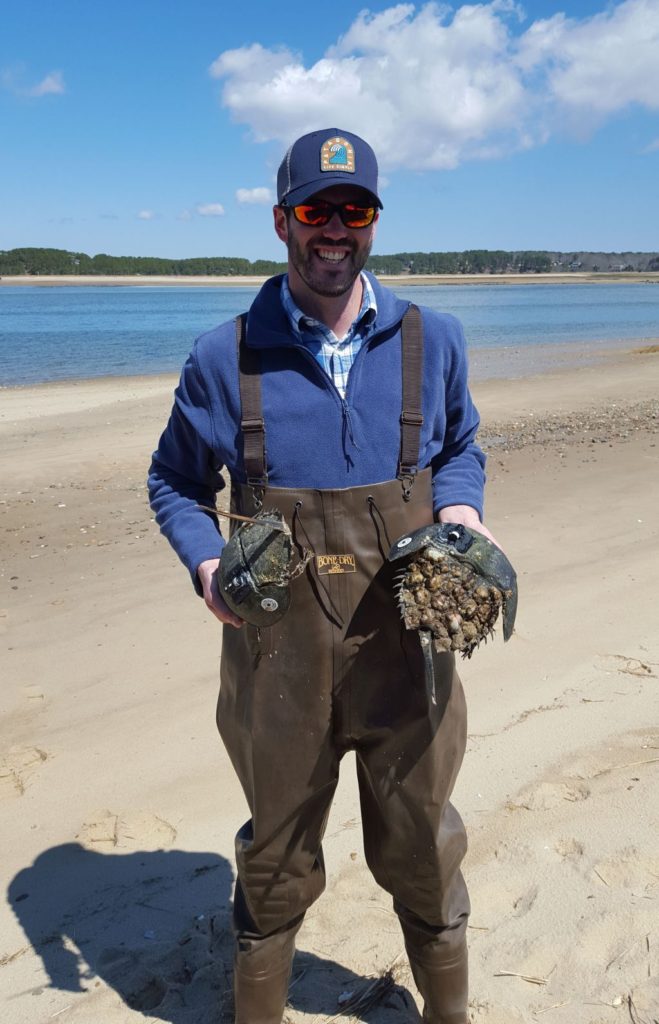
Mike Long, a master’s degree candidate at UMass Amherst, is in the second of a 2-year study of horseshoe crabs funded by the Massachusetts Environmental Trust and the Max and Victoria Dreyfus Foundation.
Our lead horseshoe crab researcher, Michael Long, has the following update on the outcomes of each of these efforts, some of which include tracking crabs in the Orleans area for comparison:
Our spawning surveys concluded on June 22, but crab abundance at our survey beaches was lower across the board compared to last year (Figures 1 and 2). The overall spawning abundance (average number of crabs per quadrat) and overall spawning index (average number of female crabs per quadrat) decreased in all three embayments we cover in our spawning surveys of Wellfleet, Nauset, and Pleasant Bays.
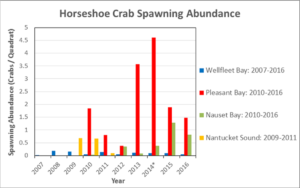
Figure 1. Annual mean horseshoe crab spawning abundance (average number of crabs per quadrat) for all surveyed embayments on the Outer Cape.
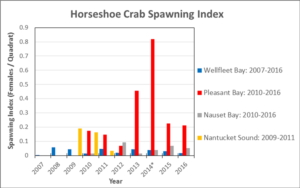
Figure 2. Annual mean horseshoe crab spawning index (average number of female crabs per quadrat) for all surveyed embayments on the Outer Cape.
Although both spawning abundance and spawning index decreased from last year, it may have just been luck of the draw due to some subpar weather on the survey days. Many surveys were done on windy days, which may have deterred crabs from going to spawning beaches. The cold start to spring also may have delayed the beginning of the spawning season for the horseshoe crabs. It’s difficult to say exactly why crab spawning activity decreased, but the decreases from last year were minor.
Button Tagging
Button tagging in cooperation with the U.S. Fish and Wildlife Service also started slowly. However, as crabs began coming ashore, the number of tags deployed continued to increase. As of June 24, 420 crabs had been tagged in Wellfleet and Nauset Bays. Also as of June 24, there had been 15 button tags re-sighted from previous years. No crabs found in Wellfleet Bay had any unusual stories to accompany their re-sightings, but one re-sighted crab found in Pleasant Bay on May 21 had been tagged four years ago on South Monomoy. That’s quite the journey for a horseshoe crab to make!
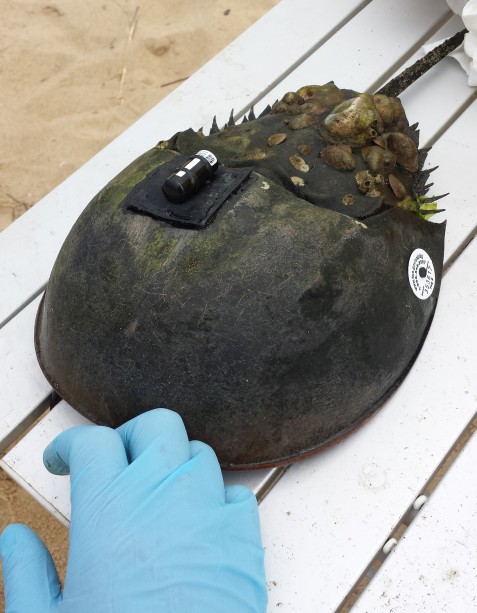
This horseshoe crab has a button tag on the left side of its carapace and an acoustic tag on top of it.
Button tagging will continue throughout the summer, so keep your eyes out for tagged crabs as you enjoy the Wellfleet and Nauset beaches.
Acoustic Telemetry
The acoustic telemetry project kicked back off in March when receivers were redeployed in Wellfleet Bay to detect the 60 crabs which were tagged last year as they became active again in the harbor. The most recent data download on June 10 showed 27 of last year’s 60 crabs had returned to Wellfleet, pretty much the result I’d expected. Tags falling off, harvest, natural mortality, or crabs simply not returning to Wellfleet Harbor could all be reasons why only about half the tagged crabs have been detected. But there is still the possibility of more crabs returning to Wellfleet in the coming months.
Another 40 acoustic tags are being deployed in 2016 in addition to the 60 tags that were deployed last year and as of June 24 there have been 31 of these tags deployed. Once all 40 of these tags are deployed, we will have 100 tagged crabs to track as they move about Wellfleet Bay for the rest of the year.
Juvenile Surveys
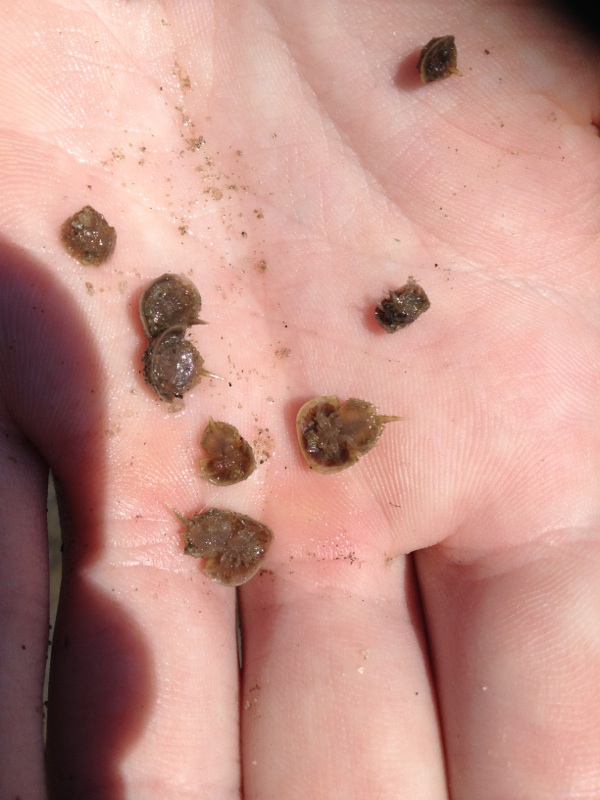
Very young horseshoe crabs at Wellfleet Bay Wildlife Sanctuary (photo courtesy of Mass. Division of Marine Fisheries).
For the second year in a row, Mass Audubon will be attempting to locate juvenile horseshoe crabs in the salt marshes of the Outer Cape. These small crabs have been very difficult to find in years past, however a few small nursery areas were discovered last year, and hopes are high for this year as well!
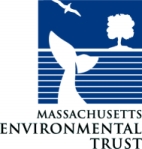


Hi Michael Long,
I am a science teacher and last spring some of my students and I accompanied the rangers at Great Kills Park in Staten Island (New York) to monitor (count and tag) horseshoe crabs on the beach at night. It was amazing and we even found a tagged one swimming near the shore and we received a pewter pin and a certificate from the U. S. Fish and Wildlife Service’s Cooperative Horseshoe Crab Tagging Program. This is what we learned about our male specimen. He was first tagged on 5/10/2013 on Plum Island, Sandy Hook Bay, NJ. Our recapture date was 6/2/2016 Great Kills Park, Raritan Bay, NY. That, coupled with the fact that we just were involved with the rangers doing A Day in the Life of the Hudson water studies and found lots of horseshoe crab molts, the students seems quite invested in these animals. We had actually thought of putting a tracker on them to see better were they go when we can across your project. We have some questions about the project (what type of tracker are you using and how much are they?) and we have a few other ideas of our own that we would like to discuss with you if you have the time. Congratulations on all the great work you are doing.
Thank you,
Mary Lee and her students from St. Clare School in Staten Island
How do you manage tagging them when they shed shells ? Don’t tags get list then?
Hi, Phila,
Good question! Here’s Mike Long’s reply:
For the button tagging and telemetry projects only adult crabs are tagged. If we tagged juvenile crabs we would definitely be concerned about losing tags as they grow and molt. However, adult crabs molt far less often than juveniles and eventually go through a terminal molt when they reach a certain age. Because of this we are confident that the tagged crabs won’t molt out of the tags, but tags falling off are also a possibility.